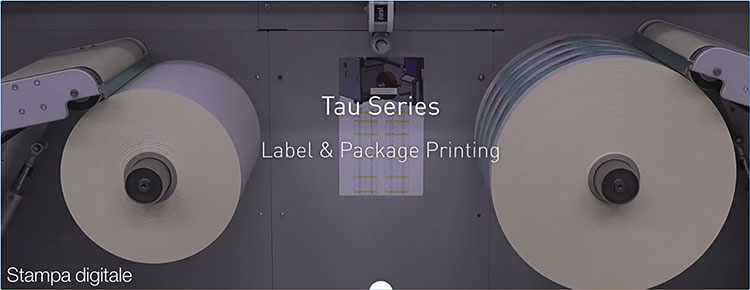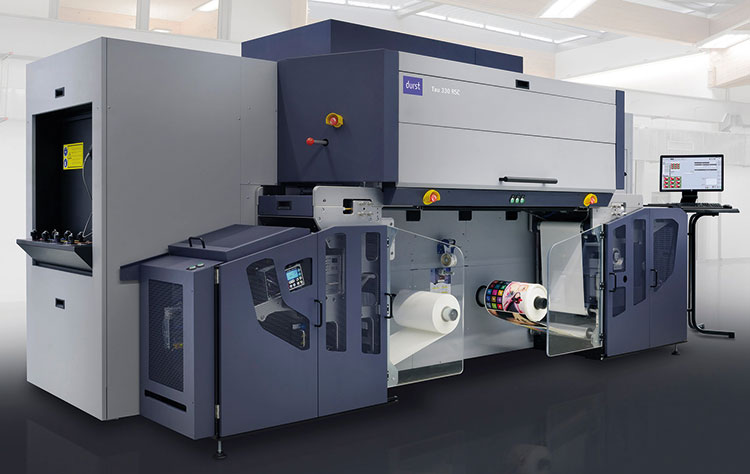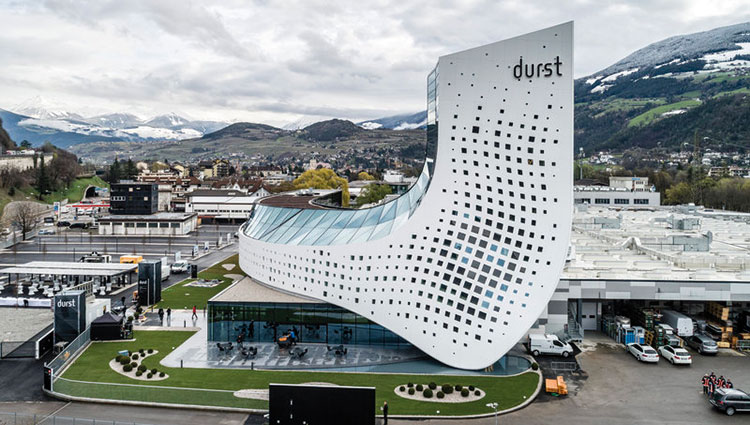Durst (and customer) Experience
Last April 12, Durst opened the doors of its new, futuristic headquarters in Bressanone to Italian label converters, to illustrate the projects that will see it involved in the coming years and that refer to an important strategic evolution, as well as to the consolidation of technological partnerships. D.B.

From a specialist in digital inkjet printing to a supplier of highly integrated solutions, ranging from image and data acquisition to printing and surface decoration, without forgetting the development of proprietary software for workflow and ink development.
This is a summary of the evolution talked about - in the new and suggestive Campus - by Helmut Munter and Martin Leitner, respectively Segment Manager and Product Manager of the Labels & Package Printing division in Durst.
Absolute protagonist of the Durst open house, the latest series of TAU 330 RSC machines, recently launched also in the “economic” version, with live demonstrations in the “Customer Experience Center”.
A reminder, for the record, that the day was enhanced by the interventions of Barbieri Electronic (manufacturer of spectrophotometers and specialized in color management systems), and Colorgraf (manufacturer of paints and solutions for digital finishing).
Experience the market, as protagonists
Durst works in 80 countries with 230 technicians, in order to be able to provide complete assistance to customers, and focuses with determination on innovation (it invests 8% of turnover in R&D).
«We invest in all the sectors in which we operate with our machines - stated Helmut Munter - hence labels, large format, corrugated cardboard, textiles, ceramics...
Indeed each division, with its special team, focuses on precise developments, in response to current market trends».
To this regard, according to Finat sources, 2019 will see an increase in demand for digital printing machines (27%), removable adhesives (20%) and low-migration inks (17%). And if in the past years, machines with toner had a 70% share, today we are facing a reversal: 73% E hybrid, 27% toner-based inkjet printing (according to Finat converter purchase plans in the next 18 months).
Digital speed and high resolution...
Durst is ready to face the emerging needs, thanks to the performance of the new TAU 330 RSC - Resolution, Speed, Colors series: 1,200 x 1,200 dpi resolution; speeds up to 78 m/min; CMYK + OVG colors.
High print quality is one of the pluses of this series, which uses Samba printheads, capable of ensuring maximum productivity: thanks to a software control, in the event of a nozzle failing, the neighboring nozzles print with a larger drop, thus compensating the delivery. Everything can be monitored with simple steps by the operator.
TAU RSC is ideal for printing labels in all sectors such as food, chemical, pharmaceutical... but also for printing on multilayer laminated tubes, blisters, folding cartons, and can reproduce variable data, in all colors and at maximum speed.

... also from a “4.0” perspective
The RSC series allows you to create an interface between the printer and the customer’s local network, as well as between the local network and the MIS (Management Information System).
«So far - Martin Leitner intervenes - digital was used for medium-small runs, but with this machine we are aiming for high speed and longer runs. We are therefore certain, with the models we are designing, we will also propose innovations in terms of printing and inks (Durst is also developing the use of low-migration inks, Ed.). Among other things, with this system, you can print indifferently on paper or plastic: the operating speed is the same with any material ».
«For the moment - recalls Munter - the only reduction in speed is with printing white (up to 52 m/min). But we are testing a new model to remedy the problem: in the coming months, once this standard has been developed, we will be able to upgrade existing machines. On the other hand, when we talk about higher speeds, we must consider the need to modify the other parameters, in particular those relating to ink and the drying system: that’s why, on the RSC, we do not use UV LEDs but traditional UV lamps, because they assure us the optimal power to obtain a perfect drying».
Collaborations
To preside over the market in the best way and offer the maximum completeness of the range, Durst has consolidated its partnership with Omet, for the production of hybrid flexo-digital printing machines and, recently, has signed a joint venture with Koenig & Bauer, which provides for the joint development of digital single-pass systems for corrugated board printing. «At the moment, with K&B we are studying a printing system for folding cartons, but we have further developments in view. Also because - concludes Munter - labeling and paper converting companies share similar problems: short runs, more personalizations and customisations... And heading towards digital can really be a competitive advantage».
Durst new headquarters: a bridge between past and future

A flat, floating wing structure with a 35-metre six-storey concrete tower and a metal powder-coated façade, where 850 multicoloured LED-illuminated windows are arranged in a pixel-like fashion reminiscent of the world of photography and digital printing.
This highly futuristic building, set amongst the mountains of Brixen in South Tyrol, took almost two years to complete and was finally opened on 5 April. It was designed by architects Patrik Pedò and Juri Pobitzer from the Bolzano-based practice Monovolume, who integrated the new wing with the existing headquarters and production facility while at the same time creating a powerful connection between past and future. The iconic design for a company building with a tower was first presented more than 50 years ago by architect Othmar Barth, creator of the first Durst facility, although it remained unbuilt.
Past and future were also the key themes of the inauguration ceremony for the new headquarters, an event that was attended by more than 1,000 guests including customers, employees, business partners and representatives of local authorities. They were welcomed by CEO and Co-Owner Christoph Gamper together with Harald and Christof Oberrauch, representatives of the family that has owned Durst for three generations.
The new building itself, which occupies 5,700 square metres of a total 28,000 sq.m site, reflects Durst’s strong focus on the well-being of its employees. The building hosts executive, commercial and technical offices combining comfort and hi-tech features. A large window looks out onto a 2,800 sq.m raised garden for use by employees and customers; there are various well-equipped relaxation areas, including a large cafeteria at the entrance, as well as spaces for a professional baby-sitting service.
This visually-striking building also features a modern conference hall and the prestigious Customer Experience Center. In this enormous showroom, customers from all over the world can try out the entire range of Durst solutions.



















